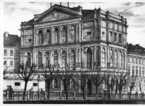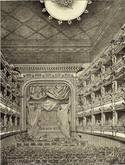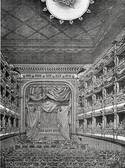Provisional Theatre
Ignác Vojtěch Ullmann
Masarykovo nábřeží 34, | |
| show on the map |
Important events
The National Theatre, opened in 1881, incorporated the Provisional Theatre into its structure.
People
A Czech architect, one of the early pioneers of the Czech Renaissance revival architecture. His work was inspired by the north Italian Late Renaissance palaces and first Renaissance revival buildings in Vienna. The most important of his works are Palác Lažanských or the building of contemporary Akademie věd České republiky .
Source: Wikipedia
More theatresHistory
Despite its short existence, the Provisional Theatre became an important milestone of the cultural development of the Czech society within the process of the Czech national revival.
The first building in Prague, intended for theatre, the Špork Theatre in na Poříčí, was operating from 1725, however, the first play in Czech language was introduced not before 1771 in v Kotcích Theatre. A more dignified space for cultural events was provided by Nostitz (presently Estate) Theatre, built at the beginning of the 1780s, when plays in Czech were taking place regularly during Sunday afternoons. Yet several decades had passed between first programmes designated for Czech audience and foundation of a separate stage. An attempt to construct the National Theatre in the Czech capital was initiated by a petition of eminent personages with Josef Frič at the head of it in 1845. Five years later, it was resumed by foundation of the Society for the Establishment of a Czech National Theatre in Prague with František Palacký as its chairman. The entire process was significantly delayed by issues related to selection of a suitable construction site, an acquisition of a suitable architectural design and understandably with securing adequate finance for the enterprise.
Because the construction had not made any substantial progress for a long time, an idea of establishing at least a provisional theatre emerged. The Regional Commission announced a decision at the beginning of 1862 that a provisional building would be erected still in the same year for theatrical performances designated for Czech spectators. The building with a somewhat pejorative name the Provisional Theatre should have solved the thorny problem for a transitional period.
The concept of the intended building contained two completely contradictory tendencies, united at the same time by the mutual ambition, how to reach the most imposing effect at the lowest cost possible. However, the visual impact of the planned building was radically different. The first tendency was the effort to demonstrate the provisional character of the building in its appearance, structure and by usage of building materials. The supporters of the opposing view intended to select majestic expression even for a provisional structure. The leading representative of the second attitude was František Ladislav Rieger, who was at the same time able to enforce the final selection of the construction site on a relatively prominent parcel by the river. He simultaneously held a rather unconventional opinion from architectural point of view that the provisional building should become the first phase of the future National Theatre. So the first structure was going to be incorporated into the final concept of the theatre, which indeed happened.
The construction of the Provisional Theatre was carried out in an extremely rapid succession. The initial plan of construction of theatre background that would be at least provisional was presented during the session of the Regional Committee on 21st April 1861. A binding decision about its actual construction was taken at the beginning of 1862 and the first spectators could see the first performance on 18th November of the same year.
The author of the architectural design was Vojtěch Ignác Ullmann, who selected Neo-Renaissance style, fashionable at that time, for his project. The Provisional Theatre was inserted into the south side of the selected plot on the riverbank of Vltava river. The architect was allowed only to use a layout of irregular, oblong plan due to the dimension of the plot. The building 's front facade, from which also the majority of spectators poured, was oriented towards Voršilská Avenue (later Ferdinand’s, Národní in the present days), but the main entrance was paradoxically located on the side of the building.
The limited financial means were manifested not only in the distinctly elevated volume of the building, but especially in its interior layout as well. The reality of low financial strength of the investor should have been veiled in representative forms. Despite it, the interior was distinguished by quite reduced space. Its relative narrowness was obvious for actors, because the stage was not provided with sufficient technical background and the orchestra pit was sized for the lowest number of musicians possible. Likewise the spectators had to be settled for mere eleven rows of seats in the stalls, a bunch of side boxes and a significant number of standing rooms. The theatre was not equipped neither with social facilities, cloak rooms, nor heating, which is puzzling considering the theatrical season, taking place in the colder part of the year.
The Society for the Establishment of a Czech National Theatre in Prague concluded a contract for the project of a National Theatre with Josef Zítek in the course of the 1860s. His monumental concept could carefully incorporate the Provisional Theatre into the final appearance of the building.
Literature:
– Karel Šípek, Vzpomínky na Prozatímní: Osm kapitol z minulosti českého divadla, Praha 1918
– Zdeněk Wirth, Antonín Matějček, Česká architektura 1800–1920, Praha 1922, s. 32–40
– František Černý a Ljuba Klosová (eds.), Dějiny českého divadla 3, Praha 1977, s. 45–54
– Josef Šnejdar (ed.), Národní divadlo 1983: Rekonstrukce a dostavba okolí, Praha 1983
– Marie Benešová, Česká architektura v proměnách dvou století: 1780–1980, Praha 1984, s. 172–173, 177
– Ernst Schremmer, Theater, in: Ferdinand Seibt (ed.), Böhmen im 19. Jahrhundert: Vom Klassizismus zur Moderne, München, Berlin, Frankfurt am Main, 1995, s. 67–69
– Růžena Baťková (ed.), Umělecké památky Prahy. Nové Město a Vyšehrad, Praha 1998, s. 258–262
– Jiří Hilmera, Česká divadelní architektura, Praha 1999, s. 25–26
– Michaela Marek, Kunst und Identitätspolitik. Architektur und Bildkünste im Prozess der tschechischen Nationsbildung, Köln – Wiemar – Wien 2004, s. 79–209
– Mojmír Horyna, Architektura přísného a pozdního historismu: Čechy 1860–1890, in: Taťána Petrasová, Helena Lorenzová (eds.), Dějiny českého výtvarného umění: 1780–1890 III/2, Praha 2001, s. 133–202, zde s. 135–136, 151, 302
Tags: Neo-Renaissance, Austrian Empire, detached building
Author: Vendula Hnídková
Vendula Hnídková:
National Theatre, Tyl Theatre Kutna Hora, Švanda's Theatre in Smíchov, New Stage of the National Theatre, Provisional Theatre, Spirála Theatre, Alfred in the Courtyard Theatre, Archa Theatre, Competition for a new Czech theatre in Prague, 1922, Minor stage ZlínTranslator: Jan Purkert
Jan Purkert:
Vienna State Opera, Theatre of Bolek Polívka, City Theatre of J.K. Tyl, Kolowrat Theatre, Theatre of Puppets Ostrava, Minor Theatre, Theatre on the Balustrade, Rokoko Theatre, Highland Theatre, South Bohemian Theatre, Jirásek's Theatre Česká Lípa, Chamber Theatre Plzeň, Chamber Venue Aréna, Minor Theatre Liberec, Town Theatre Český Krumlov, Palace Theatre in Nové Hrady, Municipal Theatre Mladá Boleslav, Naive Theatre Liberec, Silesian Theatre Opava, West Bohemia Theatre in Cheb, Karel Pippich Theatre, House of Culture and Trade Unions (DKO), City Theatre Kolín, Tyl's Theatre Lomnice nad Popelkou, Spa Theatre Luhačovice, A. Dvořák Theatre Příbram / The House of Culture, Oskar Nedbal Theatre Tábor, Masaryk's House of Culture (MKD), Hálek Town Theatre Nymburk, Pištěk's Arena Theatre, Dr. Josef Čížek Town Theatre Náchod, Theatre of Music Olomouc, Polish House, East Bohemia Theatre Pardubice, Lubomír Lipský Theatre, Fráňa Šrámek Theatre Písek, Kolár's Theatre, Municipal Theatre Turnov, Alois Jirásek Theatre, Town Theatre Znojmo, Town Theatre Žďár nad Sázavou, Town Theatre Železný Brod, Jirásek Theatre Hronov, Municipal Theatre in Broumov, J. K. Tyl`s Theatre, Dusík Theatre Čáslav, Palace Theatre in Český Krumlov, Revolving Auditorium in Český Krumlov, Theatre in the Wallenstein Palace Garden, Chamber Theatre Prague, RockOpera Praha, Uranie Theatre, Provisional Theatre, Spirála Theatre, Hanka‘s House, Božena Němcová Theatre, Na Veveří Theatre, Ta Fantastika (Black Light Theatre), Theatre in Řeznická, Palace Theatre, Comedy Theatre, Broadway Theatre, Studio Two, Image Theatre, Diviš Theatre, Architectural competition for the design of the Czech national Theatre in Brno, 1910-1913, Flat Theatre of Vlasta Chramostová, Alfa Theatre, Pardubice Competition 1961-1962, Archa Theatre, The Drama Club, Ypsilon Studio, Competition for a new Czech theatre in Prague, 1922, Cinema the World, City Theatre Chomutov, Cinema the Czech Paradise, Na Slupi Theatre, The unrealized design of the Liberated Theatre in Prague (1926-1927), Puppet Theatre in Louny, Smetana House, Vrchlický Theatre, Theatre of Petr Bezruč, House of Culture Ostrava, German House, Culture House Ostrov, By Firemen Theatre, Soběslav Culture House, Tyl's Theatre Rakovník, Municipal House of Culture Sokolov, Drama Studio, Palace Theatre in Valtice, Beskydy Theatre Nový Jičín, Palace Theatre in Žleby, Na Kovárně Theatre, Theatre in the House of Catholic Journeymen in Ostrava, Smíchov Arena Theatre, Theatres and theatre projects by Joan Brehms, Theatre Behind the Fence, City Theatre in Mnichovo Hradiště, Revolving auditorium Týn nad Vltavou, Musical Theatre Hodolany, A. V. Šembera's Theatre, Chrudim Theatre, New Town Theatre, Competition for the Realistic Theatre of Zdeňek Nejedlý in Prague, Minor stage Zlín, Arena theatres in Prague, Provisional Theatre, Palace Theatre in Měšice, A studio Rubín, All Colours Theatre, Pidivadlo, Radar Theatre, Na rejdišti Theatre, Viola Theatre, The Small Venue, Town Theatre, Kotzen Theatre, Old Drapers‘ Theatre, Radek Brzobohatý's Theatre, German House, Na Orlí Theatre, Quite a Great Theatre, Passage Theatre, Czech Theatre at the Lower Side in the Kajetán House, New Czech Theatre in the Růžová Street, Theatre hall in the building of the Women’s Homes, Continuo Theatre - Švestkový dvůr, Klub Mlejn, Comoedien-Haus, Town Theatre, Palace Theatre Duchcov, Comoedien-Haus, Palace Theatre in Teplice, Theatre in the Thun Palace, Municipal TheatreAdditional information
No information has yet been entered
Add information






























